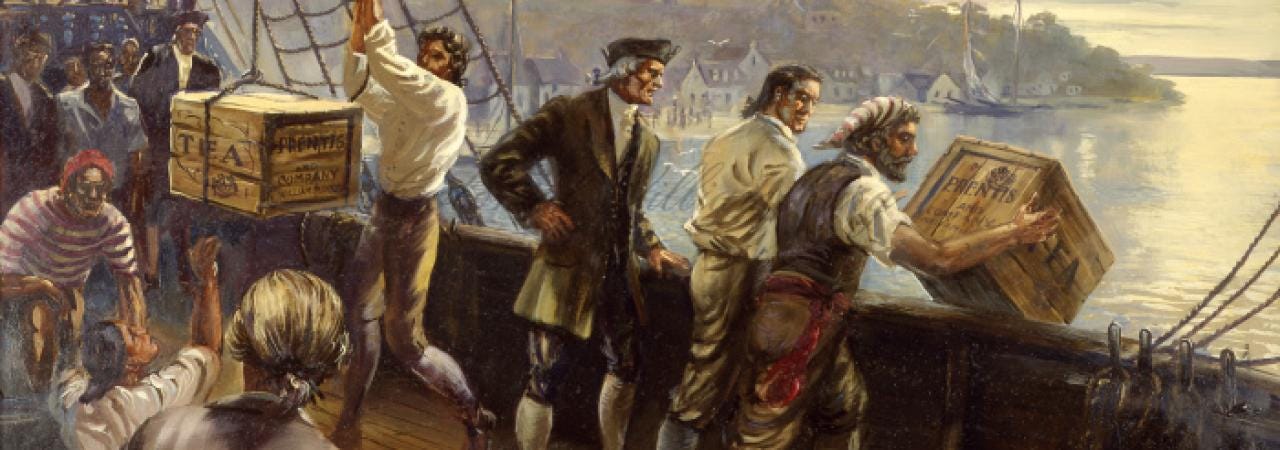Besides the rough patch of storms, Captain Benjamin Lockyer’s crossing of the Atlantic in the spring of 1774 aboard the Nancy was fairly routine. He would put in at Sandy Hook off Staten Island’s coast and contract a pilot for the approach to Manhattan’s wharf. As he approached Sandy Hook’s pier – usually a drab, uneventful place with money-grubbing locals – it was alight with onlookers carrying torches. There was also a tall pole oddly garlanded with white pendants onto which were inscribed black lettered slogans. Upon landing, locals informed the captain that it was called a Liberty Pole. Captain Lockyer realized that this tea-run would be unlike any other.
Lockyer’s shipment’s consignee, Counselor Henry White, had signed a pledge widely circulated by the so-called Sons of Liberty, against importation of untaxed British tea. White was joined in this pledge by 200 New York merchants, so he outright refused to accept delivery. The local pilots had also subscribed to the pledge, so no pilot could be contracted that night. Instead, the Sons of Liberty’s supporters at Sandy Hook removed the Nancy’s lifeboats and padlocked them at the wharf so that the crew could disembark no cargo. A pilot finally boarded the Nancy to explain the political situation to Captain Lockyer. Captain Lockyer would be guided to Manhattan and be allowed to reprovision his ship and crew. Afterwards he would return to England with his cargo intact but undelivered.
On December 16th, 1773, Boston’s now more famous “tea party” had dumped 342 chests of tea from four British ships moored in Boston Harbor. News of this event had reached the United Kingdom in late January 1774. On the present voyage, Lockyer was hauling more than double the quantity (around 700 chests of tea compressed into bricks for easier transport) which had been destroyed in Boston, so he thought best not to risk it. (Losses from the Boston Tea Party would amount to millions in today’s money). Instead, Lockyer and his crew would enjoy Manhattan’s hospitality, then sail homewards on the next wind.
Captain Chambers was less lucky. His vessel, the London, arrived three days later at Sandy Hook around noontime. Chambers denied that he was transporting tea when a pilot asked, but the Sons of Liberty had informants in ports all along the Atlantic on both banks of the pond. Consequently they knew that the London was transporting eighteen chests of British tea, exempted from tax by an act of Parliament which granted a monopoly in the tea trade to the East India Company. A multitude boarded the London the next day, and maddened by the captain’s attempted artifice, the multitude dumped the tea into the Sandy Hook Bay. Boston’s Tea-Partyers had donned Amerindian disguises, but there would be no cosplaying for these New Yorkers. They wanted the world to see them as the everyday citizens they were, indignant to have a foreign government dictate what they could consume and with whom they could trade. They escorted Captain Chambers to Manhattan and confined him under guard at an inn on Wall Street.
On April 23rd, at 9am, Captain Benjamin Lockyer offered an apology to a large crowd which had gathered in front of Fraunces Tavern at the intersection of Pearl and Broad Streets in lower Manhattan. He thanked the Sons of Liberty for the accommodation and was escorted to the Nancy anchored at Murray’s Wharf on Wall Street. Captain Chambers was also frog-marched onto the Nancy as a passenger. According to witnesses, the ship’s embarkation was celebrated by “every bell in the city rang… the ships in the harbor raised their colors in triumph, the Liberty Pole was dressed in colors and a royal salute of artillery… concluded the ceremony.”
New York’s Tea Party (the term was not used at the time, but was adopted by American historians in the 1830s) was seventh in a series of seventeen protests in North America against the tax on tea competing with the East India Company’s imports. These protests ranged in intensity from North Carolina’s milder second tea party in Edenton on October 25th, 1774, which consisted of townsfolk declaring a boycott of British tea by publication of an editorial in a London newspaper, to the harsher protest in Annapolis, Maryland on October 19th, 1774, in which locals torched a ship and its unloaded tea together in the harbor. Boston’s Tea Party of December 1773 has eclipsed all others in mainstream historiography. However, these protests – what nowadays we may term a publicity stunt – demonstrated that across vast distances and colonial subcultures, Americans could coordinate action and exert influence on a common adversary.
New York’s iteration of the Tea Party stands out in the series. Between the relatively civil treatment of Captain Lockyer and the rougher treatment of Captain Chambers, a duality emerged. It’s as if New Yorkers were saying that they’d prefer cordially to resolve the dispute about sovereignty… but if it came to it, they were prepared to defend their position by hot lead and cold steel!





Thanks Daniel for digging up all these details and narrating them in a way that is truly entertaining. Now, am I to understand (I believe I had it wrong all these years) is that the protest was not against taxes/tariffs per se, but protectionism, the unfair tax/tariff on a product from a country that country meant to favor? If all incoming tea had been taxed at the same (reasonable) rate, would the Sons of Liberty have protested? Did they want to buy their tea from a company other than East India (the Amazon of today)? Is the same problem going on today, when the government picks those companies it want to succeed?